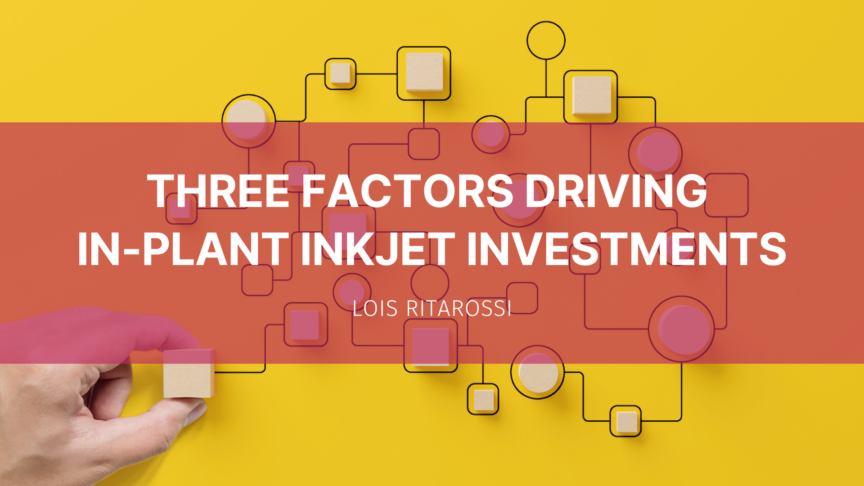Smaller in-plant operations are evaluating and installing production inkjet presses. In-plants in the manufacturing sector are migrating to inkjet to address a trifecta of challenges: labor resources, workflow automation, and printing costs.
Labor and training
Much has been reported about the ongoing labor challenges in many vertical markets and the printing industry in particular. In-plant operations across the U.S. are devising new strategies to address the convergence of:
- Aging workers retiring,
- Lack of skilled workers to run offset and finishing equipment,
- Younger workers preferring to work with technology, and
- Needing to onboard and train new employees without printing experience.
Inkjet OEMs have listened to the market and built more automation into the digital front ends (DFEs), the print platforms and workflow tools. Inkjet printing is now significantly less complex to run than offset and less complex to maintain than toner devices. In the last 3 years, several in-plants have shut down offset equipment when operators have retired. This decision has directly resulted in the acquisition of production inkjet. Operators require fewer skills to run inkjet as compared to offset. While toner can also be an analog replacement, inkjet requires less ongoing maintenance activity than toner printers. Digital toner printers require several daily maintenance steps, ongoing calibration depending on volume, and a longer monthly maintenance process. Inkjet printing has minimal steps to being job ready. Several in-plant managers report training new operators to run inkjet equipment now happens in days – as compared to weeks for toner and months for offset.
Workflow automation
The challenges with labor and older presses also lead to investments in workflow automation. At every step in the production process from receipt of order, file prep, job ticketing, print management, job tracking and finishing; in-plants are investing in software and solutions to automate, simplify and integrate workflows. In the last few years, workflow integration with inkjet platforms and business systems has been far easier with universal API interfaces and newer technologies.
In-plants typically have separate production devices and workflows for their various application needs. In my consulting work evaluating production operations, I often see 3 or 4 major workflows dedicated to black and white jobs, business color, high quality color and long run jobs. One lasting change from the pandemic is further reductions in long run jobs. Manufacturing in-plants indicate their previous long run jobs now require customization, versioning, and more frequent content updates. Long run work continues to morph to shorter run jobs. Investments in inkjet are justified, as one inkjet device often replaces 3 or 4 other printers. Inkjet runs black and white and high-quality color at lower costs than other technologies. Fewer devices simplifies the workflow and creates operational efficiencies in labor, throughput and reduction in errors.
With more cut sheet production inkjet presses to choose from, in-plants are finding inkjet delivers more than lower cost and improved uptime. It also delivers flexibility. With various types of ink sets, the options for pre-treatment and post coatings support a wider range of job types. Manufacturing in-plants run specialty stocks for labels, magnets, adhesives, indoor and outdoor signage. The expanded range of media flexibility on one inkjet device that can run documents, collateral, signage and other specialty media is a compelling justification for new inkjet investments.
At the In-Plant Printing and Mailing Association Annual Conference (IPMA), a manager from Lockheed Martin, a manufacturer of aerospace equipment, shared how they invested in inkjet and wide format platforms. Leadership saw the signage and wall coverings in the print facility, and were so impressed they asked the print manager to create signage and wall coverings for their offices and manufacturing plants. In-plant operations that align with their business units changing needs and their organizations’ leadership goals are finding inkjet enables new applications to print and the ability to insource jobs that were previously outsourced.
Cost and throughput
At several conferences this year, speakers from diverse vertical markets shared numerous inkjet success stories of improved uptime, lower cost of operation and ease of use. Inkjet has fewer moving parts that require maintenance and replacement and in some cases cost models without click costs. Calculating the total cost of operation (TCO) or a cost per finished piece with clarity on ink cost, labor and throughput considerations can prove significant cost savings with inkjet compared to toner and offset.
Many in-plants have toner devices that are beyond their lifecycle for optimal production. In evaluating new equipment, managers must consider if inkjet is the right fit for their operation. Every print operation has situational differences in their mix of work, labor force, workflow, and space considerations. Inkjet platforms offer several advantages to positively impact labor and training challenges, reduce the total number of print devices and provide flexibility to handle many types of jobs. Final decisions must include testing of specific jobs. Leveraging peer networks like the IPMA to see equipment running in similar operations is one way to gain new knowledge. Most OEMs offer job testing on specific media at different speeds to evaluate image quality and throughput. Detailed testing, media profiling, and evaluating end to end workflow inform the best outcomes for new inkjet installations.
The investment decision to move to inkjet involves creating a faster, flexible and more reliable operation with lower costs. The best decisions consider all aspects of the entire operation – people, process, cost, throughput and flexibility.

